Spiritual mind mapping is a powerful tool that combines the creative process of mind mapping with spiritual exploration. It helps you visually organize thoughts, emotions, and spiritual insights, making connecting with your inner self and divine guidance easier. Learn what spiritual mind mapping is, when to use it, and how to apply three effective personal growth and enlightenment techniques. Explore real-life examples to inspire your practice and discover how this unique approach can deepen your spiritual journey and bring clarity to your life’s path.
What is Spiritual Mind Mapping?
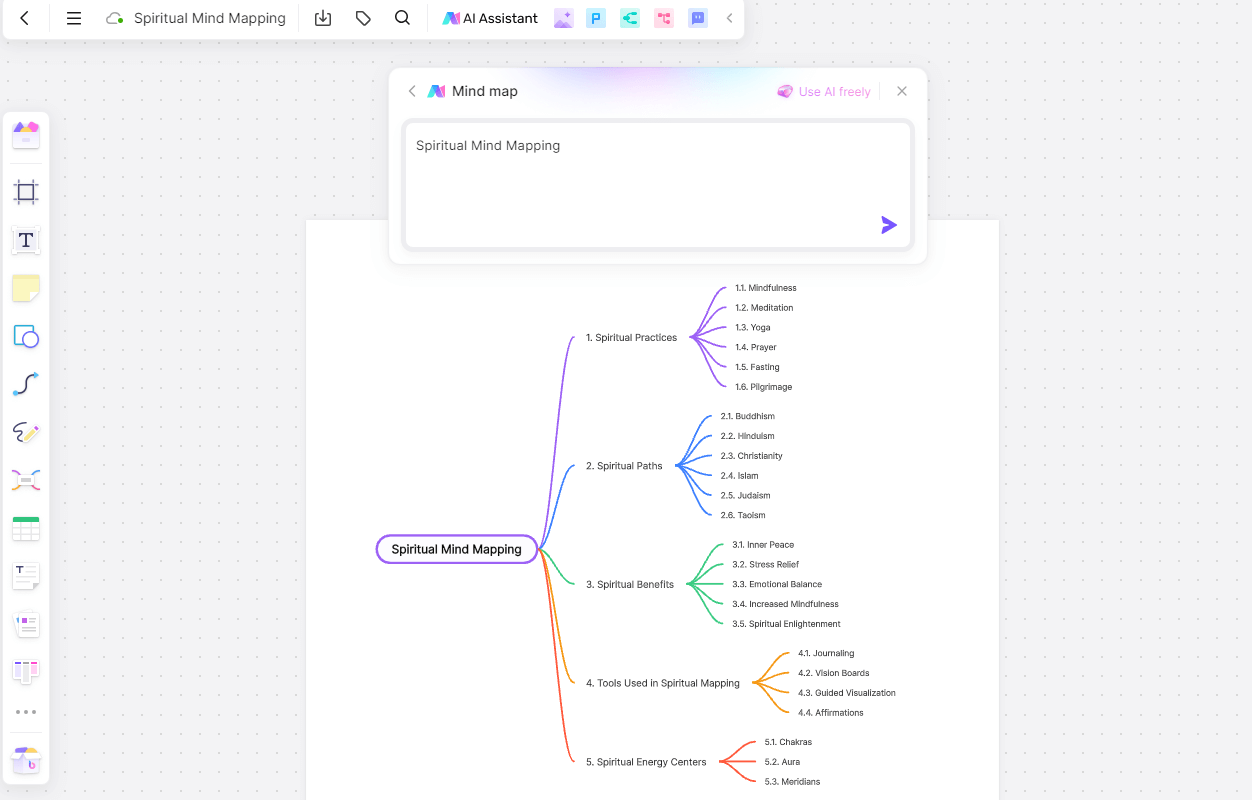
Spiritual mind mapping is a fusion of traditional mind mapping techniques with spiritual concepts. It's an innovative way to organize, visualize, and interpret spiritual ideas and relationships. The central idea, which can be a spiritual goal or value, is placed at the center of the map, from which related concepts radiate outwards in a branch-like manner. Each branch represents a different aspect of spirituality which can be broken down further into sub-branches for deeper understanding. This method stimulates both the logical and creative aspects of our brain, facilitating a deeper understanding and internalization of spiritual principles.
Spiritual Mind Mapping in Personal Growth
Spiritual mind mapping isn’t just for grasping complex ideas; it plays a big role in personal growth too:
Clearer Thoughts: By organizing spiritual ideas visually, it helps clarify your spiritual journey.
Better Memory: Visual learning sticks better. The colorful branches and symbols make it easier to remember key points.
Boosts Creativity: Building a mind map sparks creative thinking, letting you freely explore ideas.
Set Goals & Track Progress: It’s a handy tool for setting spiritual goals and tracking how far you’ve come. Regularly updating your map helps you see your growth.
When to Use Spiritual Mind Mapping?

Spiritual mind mapping is an intuitive and versatile tool that aids in traversing the multifaceted landscape of one's spiritual journey. Let's delve into those moments and periods where spiritual mind mapping can prove particularly beneficial.
Personal Transformation and Growth
One of the best times to use spiritual mind mapping is during a period of personal transformation or growth. This could be when you're embarking on a new phase of life, seeking self-improvement, or moving through a spiritual awakening. The mind map can assist in charting your spiritual progression, marking milestones, and visualizing your transformation.
Periods of Confusion or Uncertainty
Life often throws curveballs, leading to phases of confusion or uncertainty. A spiritual mind map can serve as a guide, helping to clarify your feelings, address fears, and gain a better understanding of your situation. By visually representing your current state and desired state, it can provide a clearer pathway forward.
Decision-Making Processes
When you're faced with significant decisions that require introspection and clarity, a spiritual mind map can be an invaluable ally. It allows you to map out your thoughts, feelings, and possible outcomes in a structured way, enabling you to make informed decisions that are aligned with your spiritual values and goals.
Emotional Healing and Release
If you're seeking emotional healing or wish to release pent-up emotions, turning to spiritual mind mapping can be beneficial. By visualizing your emotions and identifying triggers or patterns, the mind map serves as a therapeutic tool, assisting in understanding, managing, and healing your emotions.
Manifestation Intentions
Spiritual mind mapping can play a powerful role when you're setting manifestation intentions. By clearly outlining your desired outcome, action steps, affirmations, and resources on your mind map, you can enhance your focus, intentionality, and manifestation efforts.
Developing Self-Awareness
The journey towards greater self-awareness often requires introspection and reflection. A spiritual mind map can aid this process by creating a visual representation of your inner self – your strengths, weaknesses, beliefs, desires, and more – helping foster deeper self-understanding.
How to Use Spiritual Mind Mapping: 3 Techniques
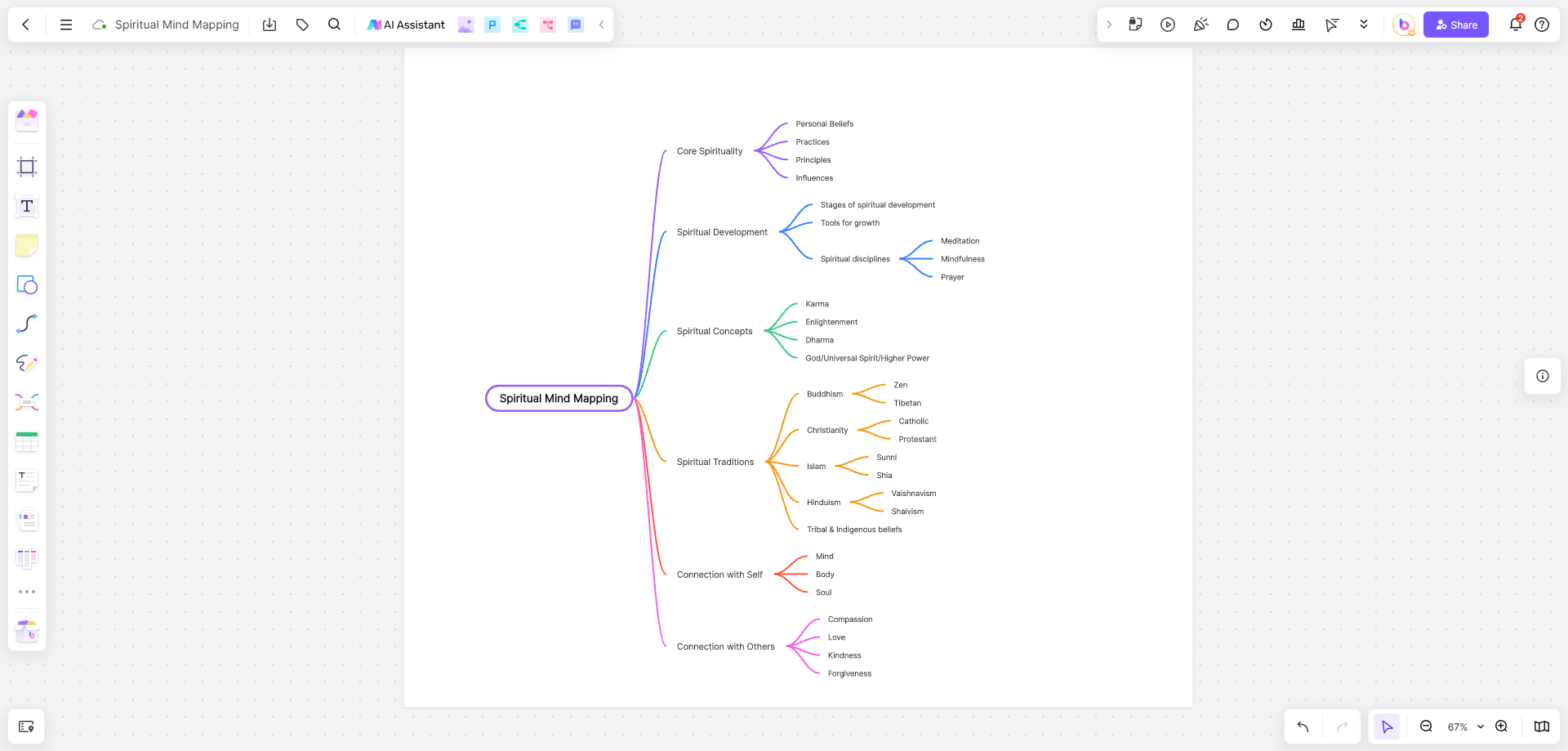
Spiritual mind mapping, though a creative and introspective process, can sometimes be daunting to begin, especially without a set direction. The key to effectively map your spiritual journey lies in techniques that align your consciousness with your subconscious. This guide aims to provide practical techniques to assist you in creating your spiritual mind map, combining the powers of meditation, journaling, and the therapeutic benefits of crystals, essential oils, and herbs.
Guided Meditation and Visualization Exercises
1. Setting Intentions: Begin your spiritual mind mapping with a clear intention. Guided meditation can help set this intention, bringing clarity and focus to your spiritual goals.
2. Visualization Exercises: Visualize your spiritual journey, principles, or goals during your meditation. Allow these visualizations to form the backbone of your spiritual mind map.
3. Incorporating Mindful Breathing: Deep and mindful breathing during meditation aids in connecting with your inner self, opening doors for introspection and understanding.
Journaling and Self-Reflection Practices
1. Daily Journaling: Journaling your daily experiences, emotions, and insights brings out patterns that could be crucial touchpoints for your spiritual journey. It creates a source of raw, personal content for your spiritual mind map.
2. Introspective Writing: Self-reflection prompts can stimulate introspective writing. Themes can include self-discovery, forgiveness, gratitude, etc., which can be subsequently represented in your spiritual mind map.
3. Dream Journaling: Documenting your dreams can be insightful as they are direct messages from the subconscious mind. They can reveal key elements that might find a place on your spiritual mind map.
Working with Crystals, Essential Oils, and Herbs
1. Incorporating Crystals: Different crystals resonate with specific frequencies and can aid in attracting desired energies. Representing these crystals on your spiritual mind map can serve as a constant reminder of the energy you wish to manifest.
2. Using Essential Oils: Essential oils like Lavender for peace or Peppermint for clarity can enhance your mind mapping session's ambiance, allowing for a deeper connection with the process.
3. Herbs as Symbols: Herbs have been used in spiritual practices across cultures. Their significance can be symbolically represented in your spiritual mind map to enhance the map's spirituality quotient.
Using the right techniques can ease the process and make it an enriching experience. Guided meditation and visualization exercises, journaling and self-reflection practices, and working with therapeutic crystals, essential oils, and herbs can help you create a comprehensive, symbolic, and insightful spiritual mind map that is reflective of your spiritual growth path.
So pick up your pen (or choose your medium), dive into introspection, channelize your creativity, embrace the silence, and let your spirit guide you in creating your own universe of spirituality on paper.
Examples of Spiritual Mind Mapping
Understanding spiritual mind mapping in a theoretical sense is one aspect, but actual examples bring a practical and realistic perspective. They can inspire, serve as starting points or show how diverse these maps can be, based on an individual's unique spiritual journey. Below, we will delve into some examples of spiritual mind mapping.
Example 1: A Self-Discovery Spiritual Mind Map
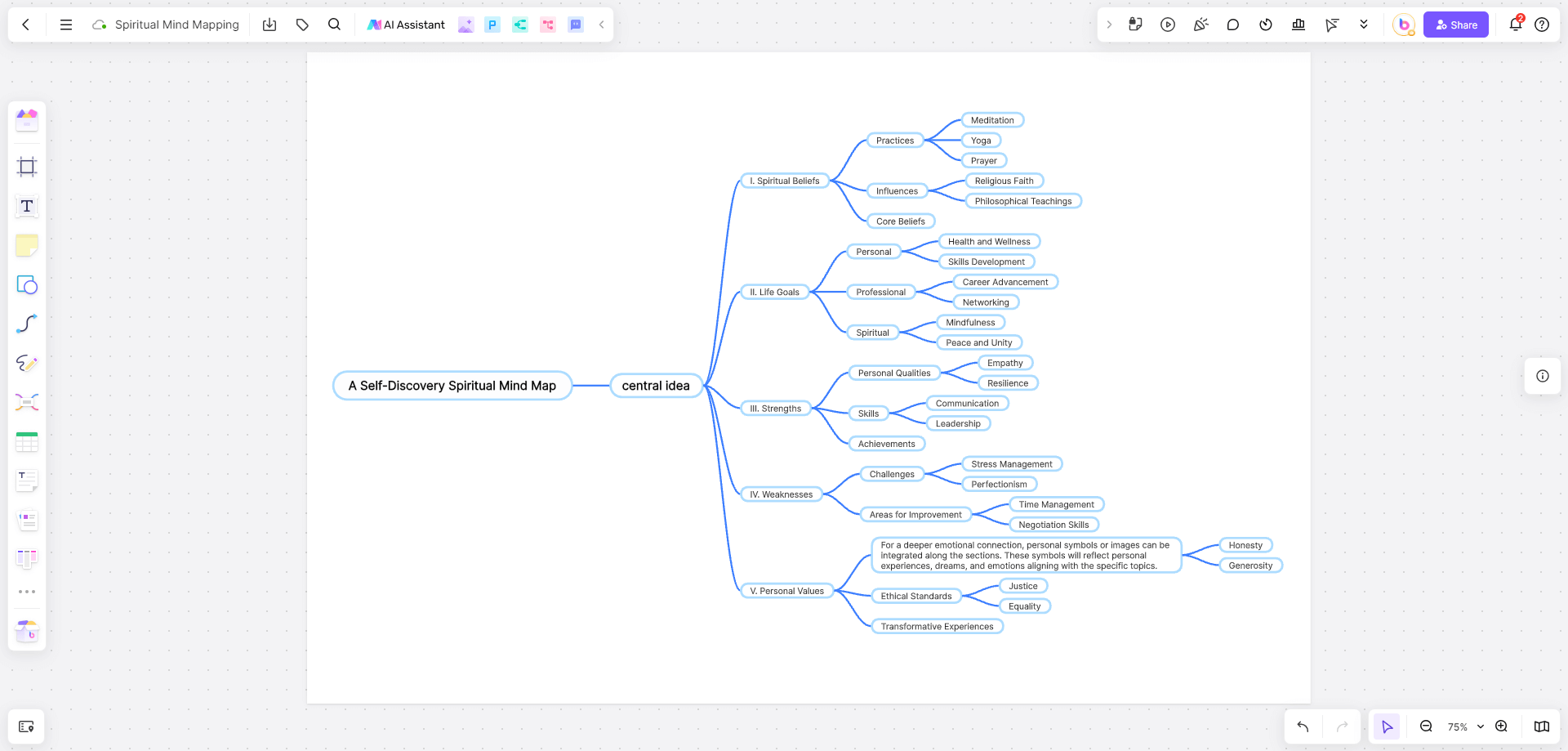
A self-discovery spiritual mind map can chart one's spiritual journey. At the center could be an image representing the individual or simply the words 'Self-Discovery'. Branches from this central idea could include 'Spiritual Beliefs', 'Life Goals', 'Strengths', 'Weaknesses', and 'Personal Values'. Each of these can further branch out to include specific elements like 'Practices', 'Milestones', or 'Transformative Experiences'. Personal symbols or images can be added for a deeper emotional connection.
Example 2: A Chakra Balance Spiritual Mind Map

This mind map focuses on the seven chakras. The central node represents the individual, with seven branches symbolizing each chakra - Root, Sacral, Solar Plexus, Heart, Throat, Third Eye, and Crown chakras. Each chakra branch can further expand into smaller branches highlighting the current state of that chakra (balanced, overactive, underactive) and the practices/actions needed for its balance (like specific meditations, affirmations, or crystal therapies).
Example 3: An Emotional Healing Spiritual Mind Map
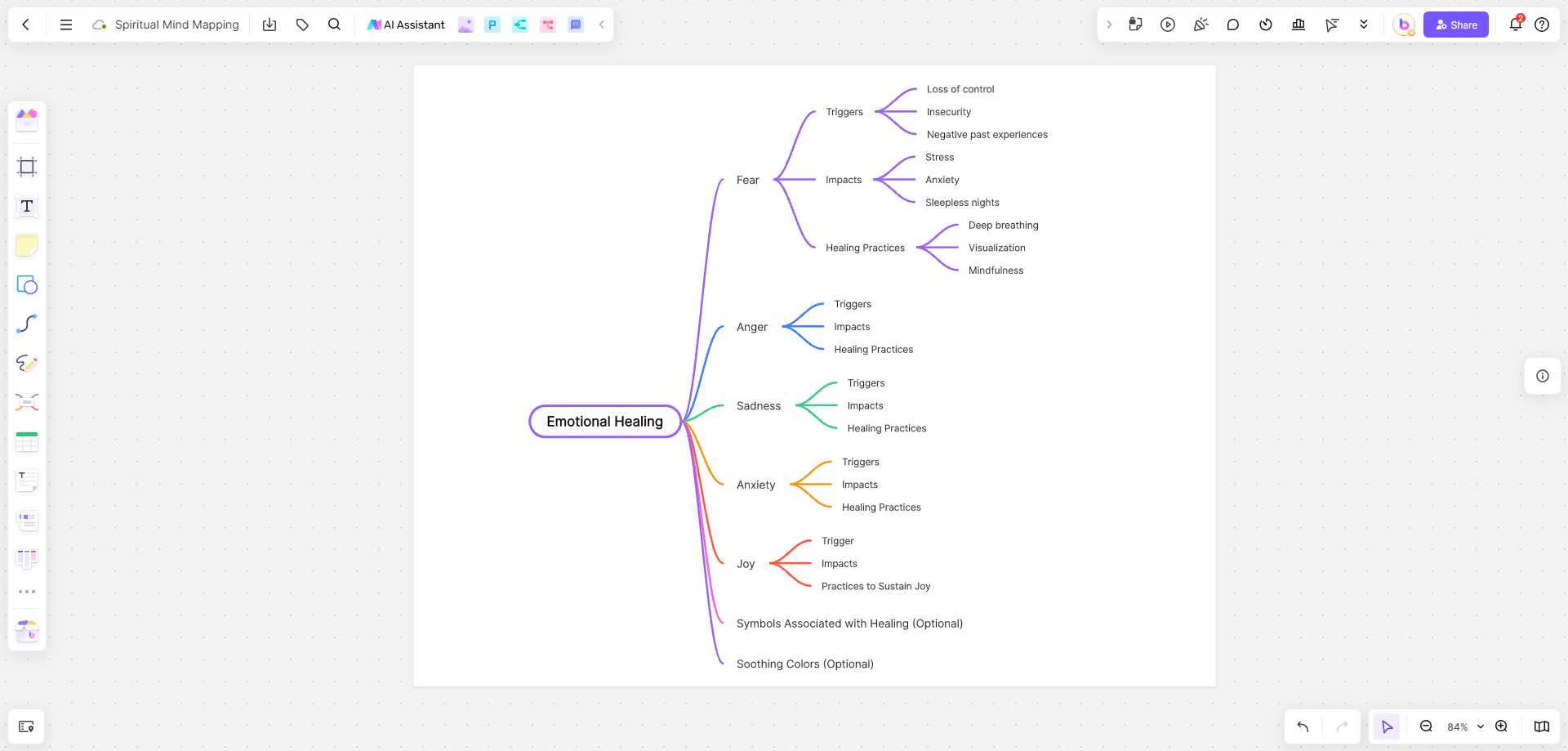
In an emotional healing mind map, the central idea could be 'Emotional Healing'. Branching nodes might represent different emotions that the person is grappling with. Each emotional node could further split into smaller branches such as 'Triggers', 'Impacts', and 'Healing Practices'. Symbols associated with healing and soothing colors can be incorporated for an additional layer of therapeutic effect.
Example 4: A Manifestation Spiritual Mind Map
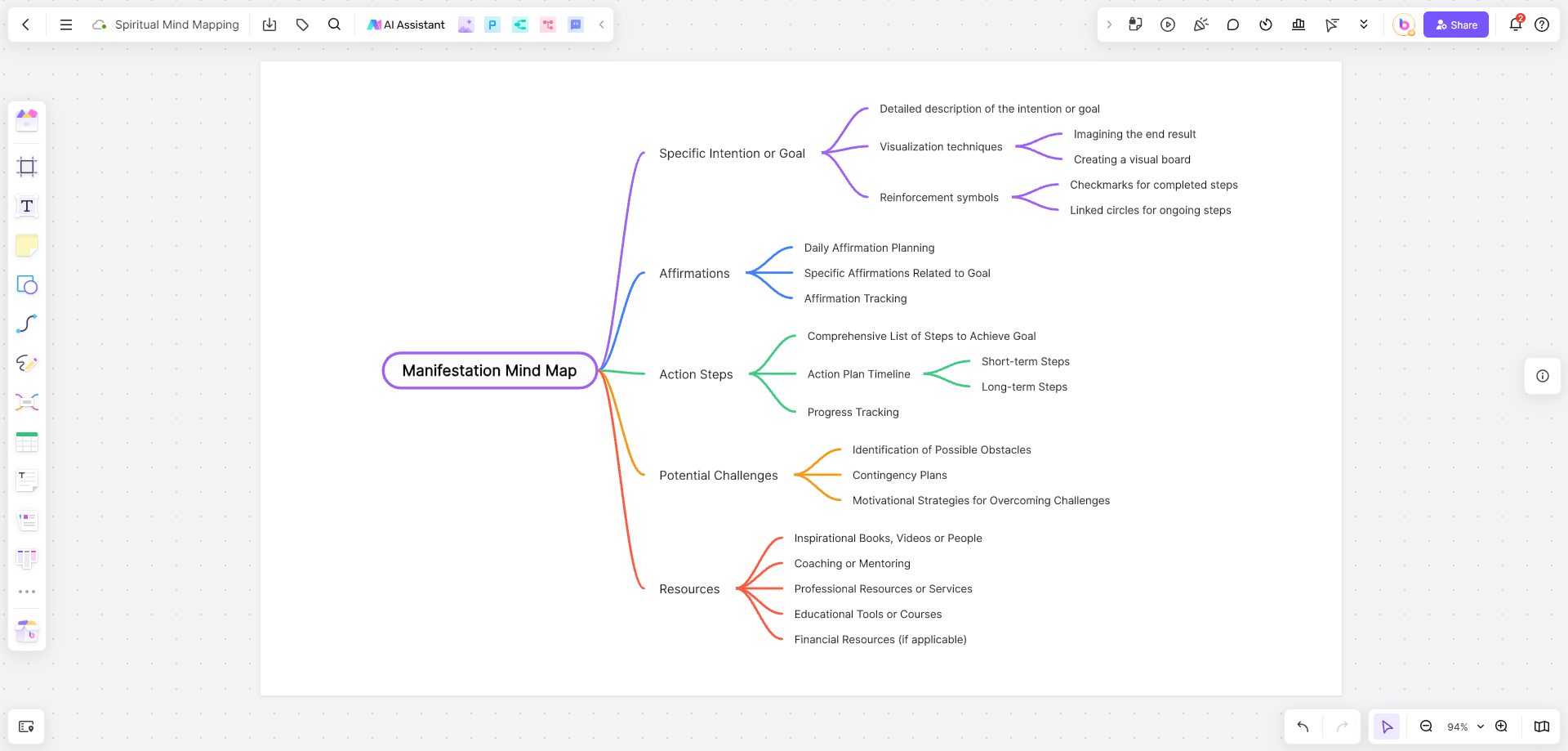
A manifestation mind map would center on a specific intention or goal the individual wishes to manifest. Nodes branching out from this could include 'Affirmations', 'Action Steps', 'Potential Challenges', and 'Resources'. Visualization of the desired outcome and reinforcement symbols like checkmarks for completed steps or linked circles for ongoing steps can add to its effectiveness.
Each spiritual mind map is a unique reflection of the individual's spiritual voyage - their aspirations, obstacles, achievements, and transformations. Whether you're embarking on a journey of self-discovery, seeking chakra balance, aiming for emotional healing or focused on manifestation - a spiritual mind map can be your personal guidebook, your intimate diary, and your milestone tracker.
Conclusion
Spiritual mind mapping is a powerful tool for deepening self-reflection, exploring beliefs, and enhancing spiritual growth. By visually organizing thoughts, it helps connect spiritual concepts and gain clarity on personal journeys. You can use spiritual mind mapping during meditation, goal-setting, or when seeking guidance. Techniques like starting with a central theme, branching out with related ideas, and using symbols or colors to represent emotions make the process more insightful. Start integrating spiritual mind mapping into your practice to unlock deeper understanding and foster meaningful connections.









